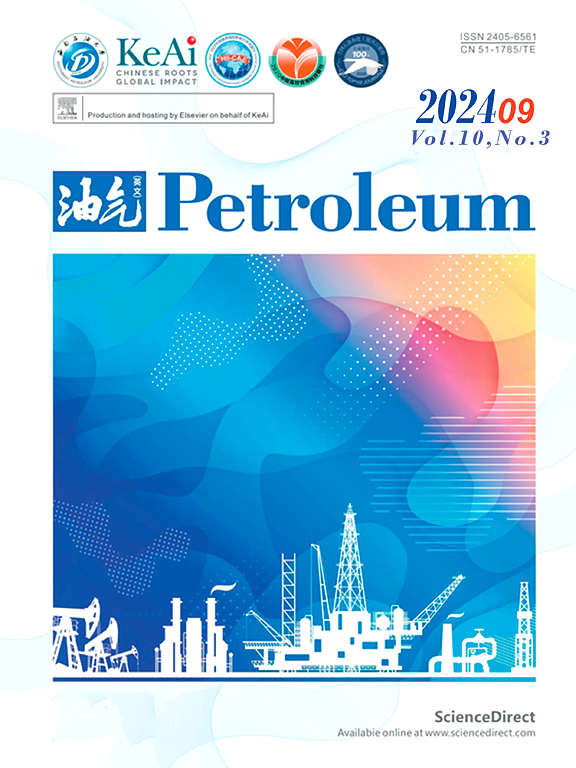Lithofacies paleogeography of the Ordovician and its petroleum exploration potential in the Middle-Upper Yangtze Area, South China
IF 3.5
Q2 ENERGY & FUELS
引用次数: 0
Abstract
Based on the drilling, logging and field analysis, this paper discusses the lithofacies paleogeography of the Ordovician and its petroleum potential in the Middle-Upper Yangtze Area, South China. Results show that Ordovician of the Middle-Upper Yangtze Region can be divided into Tongzi Formation, Honghuayuan Formation, Meitan Formation, Shizipu Formation, Pagoda Formation, Linxiang Formation and Wufeng Formation from bottom to top. During the Early Ordovician Tongzi Period and Honghuayuan Period (Tremadocian Stage), a carbonate rimmed platform developed in the study area with lots of grain shoals in Guangyuan-Weiyuan Areas and Lichuan-Tongzi Areas of Southeastern Sichuan Basin. To the Meitan Period (Floian and Dapingian and Early Darriwilian Stage), a mixed carbonate platform with clastic sedimentary rock deposition developed in study area. In Middle-late Ordovician Shizipu and Linxiang-Pagoda Period (Late Darriwilian and Hirnantian-Sandbian Stage), a carbonate ramp developed in Middle-Upper Yangtze Region. At the end of the Ordovician (Hirnantian Stage), Wufeng Formation deposited in a retention basin due to the restriction of peripheral uplift and paleo-land. Two sets of reservoir-source assemblages developed in the Ordovician, with three sets of source rocks developed in the study area. First, the lower Cambrian Qiongzhusi Formation acted as the main source rock, and the hydrocarbon migrated upward to the Ordovician reservoir along the fault. Second, the Wufeng-Longmaxi Formation acted as source rock, and hydrocarbon migrated to the Lower Ordovician along the karst crust and the fault. Third, the Lower Ordovician Meitan-Shizipu Formation acted as source rock, hydrocarbon can migrate upward to the upper Ordovician reservoir directly, which deserves exploration attention.
华南中上扬子地区奥陶系岩相古地理及其油气勘探潜力
在钻井、测井和野外分析的基础上,探讨了华南中上扬子地区奥陶系岩相古地理及其油气潜力。结果表明:中上扬子地区奥陶系自下向上可划分为桐子组、红花园组、梅坛组、十子铺组、宝塔组、临乡组和五峰组;早奥陶世桐子期—红花园期(特雷道期),研究区发育碳酸盐岩镶边台地,在川东南广源—威远地区和利川—桐子地区发育大量颗粒浅滩。至梅坛期(弗洛统、大坪统及早达里威廉期),研究区发育碎屑沉积岩混合台地。中晚奥陶世狮子铺期和临乡塔期(晚达里廉期和希尔南田-山边期),中上扬子地区发育碳酸盐岩斜坡。奥陶世末(希尔南田期)五峰组受外围隆升和古陆的制约,沉积于沉积盆地。研究区奥陶系发育2套储源组合,其中发育3套烃源岩。首先,下寒武统筇竹寺组为主要烃源岩,油气沿断裂向上运移至奥陶系储层;二是五峰组—龙马溪组为烃源岩,油气沿岩溶壳和断裂向下奥陶统运移;三是下奥陶统梅坛—石子堡组为烃源岩,油气可直接向上运移至上奥陶统储层,值得关注。
本文章由计算机程序翻译,如有差异,请以英文原文为准。
求助全文
约1分钟内获得全文
求助全文
来源期刊

Petroleum
Earth and Planetary Sciences-Geology
CiteScore
9.20
自引率
0.00%
发文量
76
审稿时长
124 days
期刊介绍:
Examples of appropriate topical areas that will be considered include the following: 1.comprehensive research on oil and gas reservoir (reservoir geology): -geological basis of oil and gas reservoirs -reservoir geochemistry -reservoir formation mechanism -reservoir identification methods and techniques 2.kinetics of oil and gas basins and analyses of potential oil and gas resources: -fine description factors of hydrocarbon accumulation -mechanism analysis on recovery and dynamic accumulation process -relationship between accumulation factors and the accumulation process -analysis of oil and gas potential resource 3.theories and methods for complex reservoir geophysical prospecting: -geophysical basis of deep geologic structures and background of hydrocarbon occurrence -geophysical prediction of deep and complex reservoirs -physical test analyses and numerical simulations of reservoir rocks -anisotropic medium seismic imaging theory and new technology for multiwave seismic exploration -o theories and methods for reservoir fluid geophysical identification and prediction 4.theories, methods, technology, and design for complex reservoir development: -reservoir percolation theory and application technology -field development theories and methods -theory and technology for enhancing recovery efficiency 5.working liquid for oil and gas wells and reservoir protection technology: -working chemicals and mechanics for oil and gas wells -reservoir protection technology 6.new techniques and technologies for oil and gas drilling and production: -under-balanced drilling/gas drilling -special-track well drilling -cementing and completion of oil and gas wells -engineering safety applications for oil and gas wells -new technology of fracture acidizing
 求助内容:
求助内容: 应助结果提醒方式:
应助结果提醒方式:


